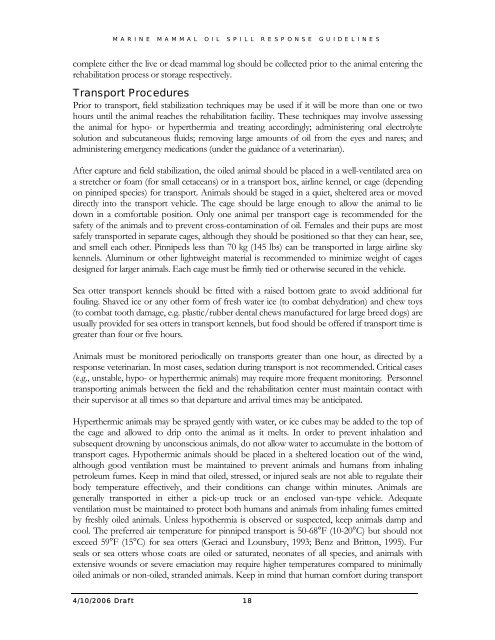Volume III, Appendices EM - National Marine Fisheries Service ...
Volume III, Appendices EM - National Marine Fisheries Service ...
Volume III, Appendices EM - National Marine Fisheries Service ...
Create successful ePaper yourself
Turn your PDF publications into a flip-book with our unique Google optimized e-Paper software.
MARINE MAMMAL OIL SPILL RESPONSE GUIDELINES<br />
complete either the live or dead mammal log should be collected prior to the animal entering the<br />
rehabilitation process or storage respectively.<br />
Transport Procedures<br />
Prior to transport, field stabilization techniques may be used if it will be more than one or two<br />
hours until the animal reaches the rehabilitation facility. These techniques may involve assessing<br />
the animal for hypo- or hyperthermia and treating accordingly; administering oral electrolyte<br />
solution and subcutaneous fluids; removing large amounts of oil from the eyes and nares; and<br />
administering emergency medications (under the guidance of a veterinarian).<br />
After capture and field stabilization, the oiled animal should be placed in a well-ventilated area on<br />
a stretcher or foam (for small cetaceans) or in a transport box, airline kennel, or cage (depending<br />
on pinniped species) for transport. Animals should be staged in a quiet, sheltered area or moved<br />
directly into the transport vehicle. The cage should be large enough to allow the animal to lie<br />
down in a comfortable position. Only one animal per transport cage is recommended for the<br />
safety of the animals and to prevent cross-contamination of oil. Females and their pups are most<br />
safely transported in separate cages, although they should be positioned so that they can hear, see,<br />
and smell each other. Pinnipeds less than 70 kg (145 lbs) can be transported in large airline sky<br />
kennels. Aluminum or other lightweight material is recommended to minimize weight of cages<br />
designed for larger animals. Each cage must be firmly tied or otherwise secured in the vehicle.<br />
Sea otter transport kennels should be fitted with a raised bottom grate to avoid additional fur<br />
fouling. Shaved ice or any other form of fresh water ice (to combat dehydration) and chew toys<br />
(to combat tooth damage, e.g. plastic/rubber dental chews manufactured for large breed dogs) are<br />
usually provided for sea otters in transport kennels, but food should be offered if transport time is<br />
greater than four or five hours.<br />
Animals must be monitored periodically on transports greater than one hour, as directed by a<br />
response veterinarian. In most cases, sedation during transport is not recommended. Critical cases<br />
(e.g., unstable, hypo- or hyperthermic animals) may require more frequent monitoring. Personnel<br />
transporting animals between the field and the rehabilitation center must maintain contact with<br />
their supervisor at all times so that departure and arrival times may be anticipated.<br />
Hyperthermic animals may be sprayed gently with water, or ice cubes may be added to the top of<br />
the cage and allowed to drip onto the animal as it melts. In order to prevent inhalation and<br />
subsequent drowning by unconscious animals, do not allow water to accumulate in the bottom of<br />
transport cages. Hypothermic animals should be placed in a sheltered location out of the wind,<br />
although good ventilation must be maintained to prevent animals and humans from inhaling<br />
petroleum fumes. Keep in mind that oiled, stressed, or injured seals are not able to regulate their<br />
body temperature effectively, and their conditions can change within minutes. Animals are<br />
generally transported in either a pick-up truck or an enclosed van-type vehicle. Adequate<br />
ventilation must be maintained to protect both humans and animals from inhaling fumes emitted<br />
by freshly oiled animals. Unless hypothermia is observed or suspected, keep animals damp and<br />
cool. The preferred air temperature for pinniped transport is 50-68°F (10-20°C) but should not<br />
exceed 59°F (15°C) for sea otters (Geraci and Lounsbury, 1993; Benz and Britton, 1995). Fur<br />
seals or sea otters whose coats are oiled or saturated, neonates of all species, and animals with<br />
extensive wounds or severe emaciation may require higher temperatures compared to minimally<br />
oiled animals or non-oiled, stranded animals. Keep in mind that human comfort during transport<br />
4/10/2006 Draf t 18
















